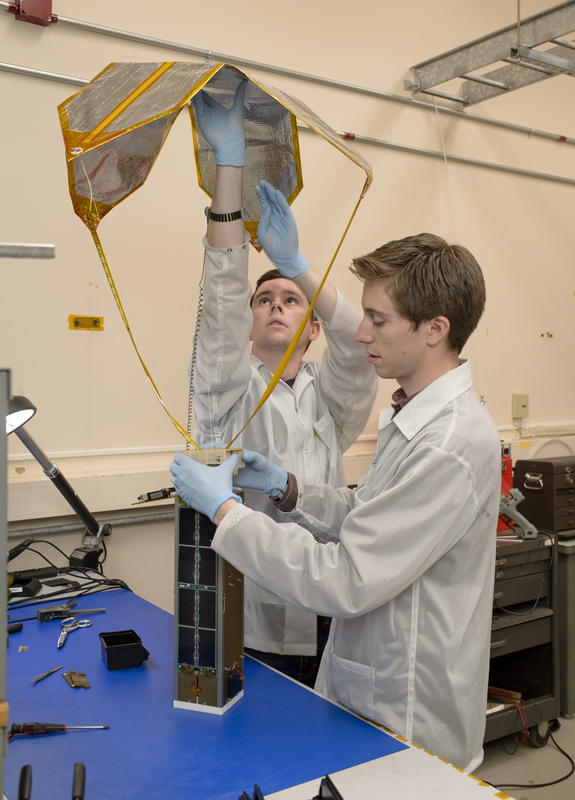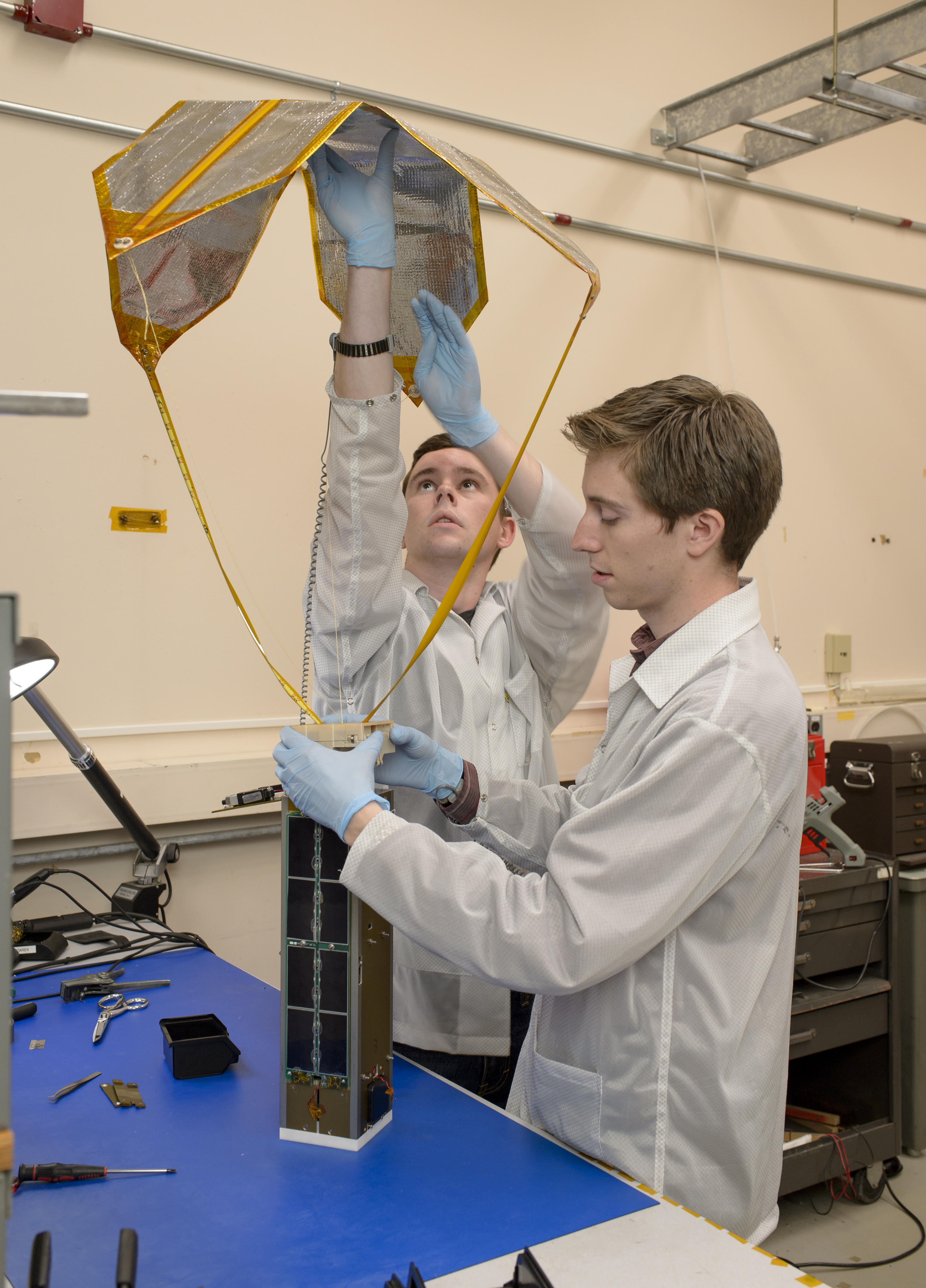A novel technology that could allow for accurate, guided landing of payloads returning to Earth from the International Space Station will soon undergo testing in orbit.
The technology, called “Exo-Brake,” is a “tension-based, flexible braking device resembling a cross-parachute that deploys from the rear of a satellite to increase the drag,” NASA officials said in a statement.
Developed and tested by engineers at NASA’s Ames Research Center in California, the Exo-Brake is a de-orbit device that would be used in place of more complicated systems, the statement said. Those other systems use thrusters to slow down and guide a spacecraft during re-entry through Earth’s atmosphere, according to the statement. [In Pictures: NASA’s Flying Saucer for Spacecraft Landings]
An Exo-Brake system was packed inside the Technical Education nanosatellite (TechEdSat-5) and delivered to the space station aboard the Japanese Aerospace Exploration Agency’s robotic H-II Transfer Vehicle 6 on Tuesday (Dec. 13). The de-orbit device will be put to the test when the nanosatellite is deployed from the orbiting lab in early 2017.


Credit: NASA Ames/Dominic Hart
“The Exo-Brake’s current design uses a hybrid system of mechanical struts and flexible cord with a control system that ‘warps’ the Exo-Brake — much like how the Wright brothers used warping to control the flight behavior of their first wing design,” Marcus Murbach, principal investigator and inventor of the Exo-Brake device, said in the statement.
Additionally, engineers will use real-time simulations of the spacecraft’s orbital trajectory to guide the craft to a desired atmospheric entry point.
Earlier versions of the Exo-Brake technology have been tested on balloons and suborbital rockets, according to the statement.
“In addition to the goal of returning samples from the space station, the project seeks to develop ‘building blocks’ for larger-scale systems that might enable future small or nanosatellite missions to reach the surface of Mars and other planetary bodies in the solar system,” NASA officials said.
Mission controllers confirmed that a small satellite launched from the International Space Station (ISS) on November 20 has successfully entered its orbit. Soon it will demonstrate two new technologies including a communications system to provide precise information about the spacecraft’s position, as well as an ‘Exo-Brake’ device to demonstrate a new de-orbit technique. The latter may be regarded as a specially designed parachute that operates at extremely low pressures.
The satellite, dubbed “TechEdSat-3p,” arrived at the station aboard a Japanese H-II Transfer Vehicle August 3, 2013. It was released at 3 a.m. EST November 20, from the same Japanese Small Satellite Orbital Deployer aboard the station that launched its smaller predecessor – TechEdSat-1 – in 2012.
“TechEdSat-3p will be the first nano-satellite of its size deployed from the ISS – a ‘3U’ configuration,” said Marcus Murbach, the TechEdSat-3p principal investigator at Ames.
TechEdSat-3p is equipped with a short-burst data modem from Iridium Communications Inc., McLean, Va., combined with a GPS receiver to perform communications functions including providing data about the spacecraft health and space environment. The primary experiment is the ‘Exo-Brake’, an exo-atmospheric passive braking device that will eventually enable small samples to be returned from the ISS or other orbital platforms.
“TechEdSat-3p uses a completely new nano-satellite communication paradigm in that the Iridium and GPS orbiting spacecraft replace ground stations for tracking, rapid data retrieval and uplink capability,” said Murbach. “Eventually, these technologies could be combined to provide another way to return cargo from the space station or other orbiting platforms.”
TechEdSat-3p is the second satellite in the TechEdSat series to successfully achieve orbit. The TechEdSat Series uses the CubeSat standards established by the California Polytechnic State University in San Luis Obispo, that specifies nanosatellites in one unit (1U) increments of 10x10x10 centimeters. TechEdSat-3p is a 3U satellite and weighs approximately 5 lbs. Previously, the TechEdSat-1 – a 1U CubeSat – successfully demonstrated the use of the basic communications subsystem and radiation-tolerant controller during the previous year. It functioned in orbit for seven months until it re-entered Earth’s atmosphere. It was followed by a successful Iridium system flight test in April, 2013.
“The satellite’s structure, avionics, and payload, were custom-designed by the team to utilize the 3U volume most efficiently and provide ample space for the deorbiter function – the Exo-Brake,” said Murbach. “The hardware was mostly off the shelf components available to anyone – this makes it easier to reproduce and make adjustments for future flights – as well as providing a tremendous education capability”

Credits: NASA
For example, the TechEdSat-4 satellite, proposed for launch in 2014, will be very similar to the TechEdSat-3p design. It will further develop the passive deorbiting system by adding a unique drag-modulation capability for accurate de-orbit and eventual re-entry control. Future TechEdSats also will validate hardware for possible nanosatellite missions to the surface of Mars – also of great interest to Murbach’s team.
“This project uniquely pairs advanced university students with NASA researchers in a rapid design-to-flight experience,” said SJSU’s Dr. Periklis Papadopoulos (one of the co-investigators). “It also provides a platform to test technologies for future NASA Earth and planetary missions, as well as providing students with an early exposure to flight hardware development and management.”
TechEdSat-3p was developed, integrated, and tested at NASA’s Ames Research Center in Moffett Field, California by student interns from San Jose State University (Dr. Papadopoulos) in California and the University of Idaho (Dr. Atkinson). TechEdSat-3p is funded by the Engineering Directorate at NASA Ames Research Center and the Human Exploration and Operations Mission Directorate at NASA Headquarters. The total cost was less than $50k (in parts) because the team primarily used commercial off-the-shelf hardware and simplified the design and mission objectives.
